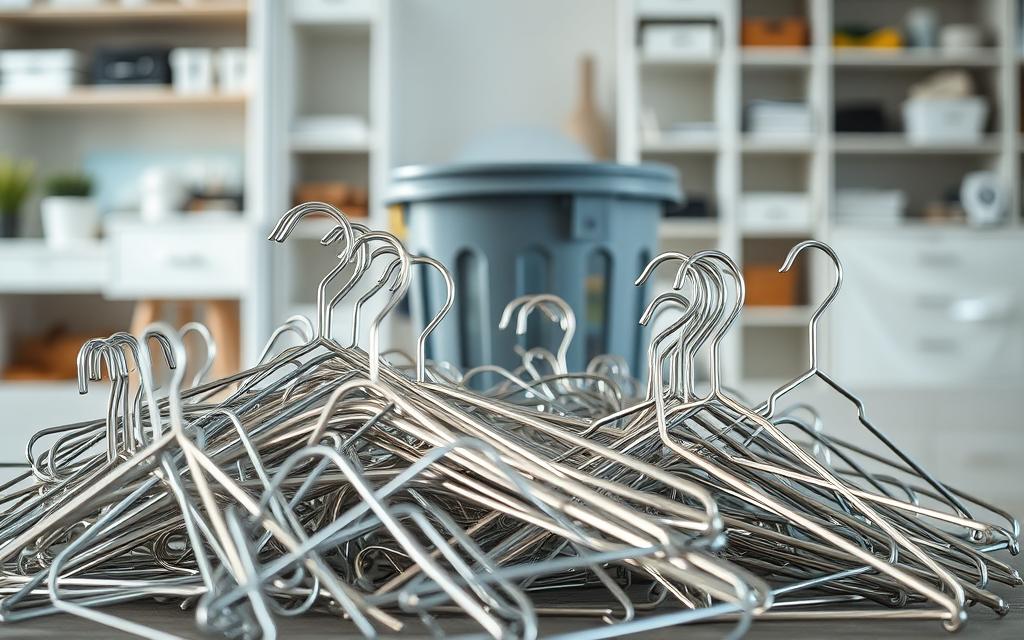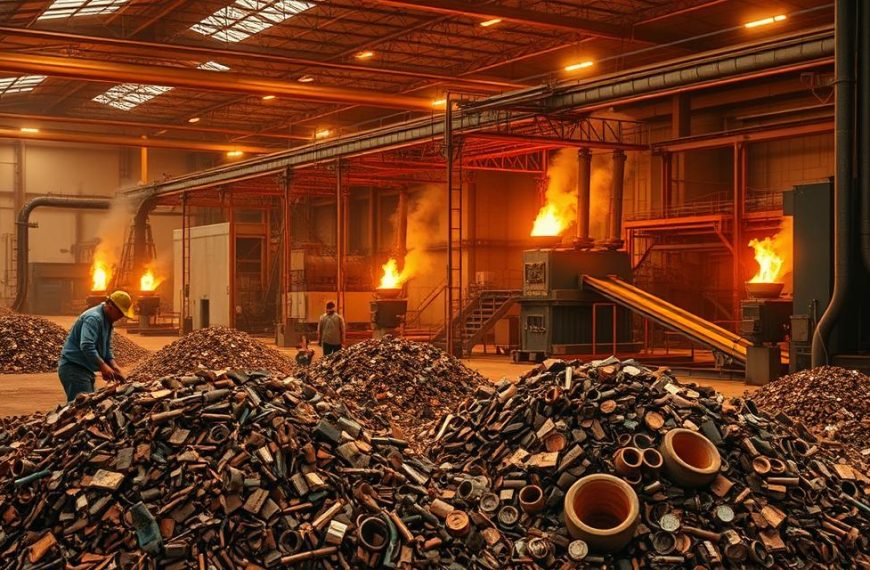Every year, the U.S. discards an astonishing 3.5 billion wire hangers, contributing to a growing environmental concern. Globally, the production of hangers reaches 10 billion annually, yet only 15% of these items are recycled. This low rate persists despite the fact that many hangers are made from recyclable materials.
Wire hangers, often perceived as recyclable, present practical challenges in the recycling process. Their mixed materials and design complicate standard recycling systems. However, solutions like specialized recycling programs and scrap metal options offer hope.
Companies like Mainetti are leading the way with improved hanger designs that are easier to recycle. Tools like Recycle Coach also help individuals improve their disposal habits. Addressing this issue is urgent, as the impact on landfills continues to grow.
Understanding the Recycling Challenges of Metal Clothes Hangers
The unique shape of wire hangers creates problems for recycling equipment. Their hooked ends and tangled nature disrupt the sorting process, leading to frequent shutdowns and costly repairs.
Why Metal Hangers Are Problematic for Recycling Centers
Wire hangers often jam sorting machinery at 85% of recycling facilities. Their hooked ends snag conveyor belts, causing emergency shutdowns and requiring repairs that cost over $2,000 per incident.
Workers also face safety risks. Protruding hooks can cause lacerations, and tangled materials account for 67% of recycling facility injuries.
The Risks of Placing Hangers in Recycling Bins
Placing wire hangers in recycling bins can damage equipment. Their mixed-material construction, combining steel wire with plastic coatings, complicates processing. This makes separation difficult and reduces efficiency.
Facilities like the Burbank Recycle Center explicitly ban hangers due to these challenges. Other problematic items, such as plastic bags and Christmas lights, share similar issues.
“The design of wire hangers poses significant risks to both machinery and workers, making them unsuitable for standard recycling processes.”
| Issue | Impact | Cost |
|---|---|---|
| Jammed Rollers | Emergency Shutdowns | $2,000+ per incident |
| Worker Injuries | Lacerations from hooks | Increased safety costs |
| Material Separation | Reduced efficiency | Higher processing fees |
Can You Recycle Metal Clothes Hangers? Exploring the Options
Finding proper disposal methods for wire hangers can be challenging. While many facilities avoid them due to their design, specific recycling options exist. Understanding where and how to dispose of these items responsibly is key to reducing waste.
Recycling Centers That Accept Metal Hangers
Some recycling centers, like the Burbank Recycle Center, accept stripped wire hangers in designated metal bins. Removing paper or plastic wraps is essential to meet their requirements. This step ensures the materials are clean and ready for processing.
Approximately 30% of municipal centers in the U.S. offer drop-off points for these items. Using tools like Earth911 can help locate nearby facilities. Simply enter your zip code to find centers that accept wire hangers.
Scrap Metal Recyclers: An Alternative Solution
Scrap metal recyclers provide another viable option. With over 1,400 processors across the U.S., these facilities specialize in handling steel and other metals. Clean steel hangers can fetch between $0.08 and $0.12 per pound at most scrap yards.
Steel’s infinite recyclability makes it a sustainable choice. Recycling one pound of steel saves 1.5 kilograms of CO2, significantly reducing environmental impact. However, contamination thresholds must be met, with non-ferrous materials limited to 5% or less.
“Scrap metal recyclers offer a practical solution for disposing of wire hangers while contributing to environmental sustainability.”
- Remove all paper or plastic wraps before recycling.
- Use Earth911 to locate nearby drop-off points.
- Understand scrap yard payment structures based on weight.
- Compare the carbon footprint of steel versus plastic alternatives.
Reusing and Donating Metal Hangers: Sustainable Alternatives
Reusing and donating wire hangers offers a sustainable way to reduce waste. Many communities have established programs to repurpose these items, keeping them out of landfills. By exploring these options, individuals can contribute to a greener future.
Returning Hangers to Dry Cleaners
Dry cleaners often accept wire hangers for reuse. According to the National Cleaners Association, 78% of dry cleaners welcome returns. This practice not only reduces waste but also supports businesses in lowering their costs.
For bulk returns, call ahead to confirm policies. Bundling hangers with twine ensures they are easy to handle. Many dry cleaners appreciate this effort, as it simplifies their workflow.
Donating Hangers to Thrift Stores or Local Communities
Thrift stores like Goodwill process millions of donated hangers annually. Organizations such as the Salvation Army also accept these items, provided they are in good condition. Donating is a simple way to support local communities while reducing waste.
Programs like NYC’s “Hanger Exchange” have successfully redirected millions of hangers from landfills. Community swap events, often organized through platforms like Nextdoor or Buy Nothing groups, offer additional opportunities to donate.
- Call ahead to confirm thrift store policies before donating.
- Participate in community swap events to share unused hangers.
- Explore corporate take-back programs, such as Zara’s hanger recycling initiative.
- Partner with nonprofits like Dress for Success for hanger drives.
“Donating hangers to thrift stores and dry cleaners is a practical way to reduce waste and support local communities.”
Reducing Hanger Waste: Practical Tips for Everyday Life
Small changes in daily habits can make a big difference in reducing waste. By adopting simple practices, individuals can minimize their environmental impact over time. This section explores practical tips and creative solutions to address hanger waste effectively.
Bringing Your Own Hangers to Dry Cleaners
Many dry cleaners welcome customers who bring their own hangers. This practice not only reduces waste but also supports businesses in lowering their costs. Some retailers, like EcoCleaners, even offer a 15% discount for BYOH (Bring Your Own Hanger) customers.
Before visiting, confirm policies with local cleaners. Bundling hangers with twine ensures they are easy to handle. This simple step can save time and contribute to a healthier environment.
Creative Upcycling Ideas for Old Metal Hangers
Old wire hangers can be transformed into useful items through creative upcycling. DIY projects, such as turning hangers into pot racks or key holders, are gaining popularity. These projects not only reduce waste but also add a personal touch to your home.
Safety is key when reshaping steel hangers. Use gloves and pliers to avoid injuries. Tutorials and workshops, like Seattle’s “Hanger Art Month,” provide inspiration and guidance for beginners.
“Creative upcycling offers a sustainable way to repurpose old items while reducing environmental impact.”
| Material | Weight Capacity | Lifespan |
|---|---|---|
| Wood | 10 lbs | 7 years |
| Steel | 15 lbs | 10 years |
| Plastic | 5 lbs | 3 years |
- Negotiate BYOH policies with local cleaners to save money.
- Compare weight capacities of wood, steel, and plastic hangers.
- Explore tutorials for transforming hangers into functional items.
- Participate in municipal workshops for hands-on learning.
Conclusion: Making Responsible Choices with Metal Hangers
Sustainability starts with small, conscious decisions in daily life. Reusing and properly disposing of household items, like hangers, can significantly reduce waste. The industry aims to achieve 40% recycled-content hangers by 2030, highlighting the importance of responsible material use.
Auditing your household inventory is a simple yet effective step. By opting for durable materials and supporting recycling programs, individuals can contribute to a greener future. Collective action, such as one million households saving 87 million hangers, demonstrates the potential for meaningful change.
Resources like the EPA guidelines and the iRecycle app provide valuable tools for making informed choices. Embracing sustainability in everyday actions ensures a healthier planet for future generations.

















